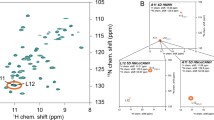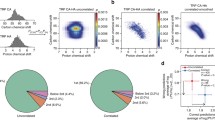Abstract
The process of resonance assignment represents a time-consuming and potentially error-prone bottleneck in structural studies of proteins by solid-state NMR (ssNMR). Software for the automation of this process is therefore of high interest. Procedures developed through the last decades for solution-state NMR are not directly applicable for ssNMR due to the inherently lower data quality caused by lower sensitivity and broader lines, leading to overlap between peaks. Recently, the first efforts towards procedures specifically aimed for ssNMR have been realized (Schmidt et al. in J Biomol NMR 56(3):243–254, 2013). Here we present a robust automatic method, which can accurately assign protein resonances using peak lists from a small set of simple 2D and 3D ssNMR experiments, applicable in cases with low sensitivity. The method is demonstrated on three uniformly 13C, 15N labeled biomolecules with different challenges on the assignments. In particular, for the immunoglobulin binding domain B1 of streptococcal protein G automatic assignment shows 100 % accuracy for the backbone resonances and 91.8 % when including all side chain carbons. It is demonstrated, by using a procedure for generating artificial spectra with increasing line widths, that our method, GAMES_ASSIGN can handle a significant amount of overlapping peaks in the assignment. The impact of including different ssNMR experiments is evaluated as well.







Similar content being viewed by others
References
Alexandrescu AT (2001) An NMR-based quenched hydrogen exchange investigation of model amyloid fibrils formed by cold shock protein A. Pac Symp Biocomput 6:67–78
Altieri AS, Byrd RA (2004) Automation of NMR structure determination of proteins. Curr Opin Struct Biol 14(5):547–553
Atreya HS, Sahu SC, Chary KVR, Govil G (2000) A tracked approach for automated NMR assignments in proteins (TATAPRO). J Biomol NMR 17(2):125–136
Baran MC, Huang YJ, Moseley HNB, Montelione GT (2004) Automated analysis of protein NMR assignments and structures. Chem Rev 104(8):3541–3555
Bartels C, Billeter M, Guntert P, Wuthrich K (1996) Automated sequence-specific NMR assignment of homologous proteins using the program GARANT. J Biomol NMR 7(3):207–213
Bartels C, Guntert P, Billeter M, Wuthrich K (1997) GARANT—a general algorithm for resonance assignment of multidimensional nuclear magnetic resonance spectra. J Comput Chem 18(1):139–149
Bouvignies G, Meier S, Grzesiek S, Blackledge M (2006) Ultrahigh-resolution backbone structure of perdeuterated protein GB1 using residual dipolar couplings from two alignment media. Angew Chem Int Ed 45(48):8166–8169
Cela E (1998) The quadratic assignment problem. Theory and Algorithms. Kluwer Academic Publishers, Dordrecht
Chevelkov V, Rehbein K, Diehl A, Reif B (2006) Ultrahigh resolution in proton solid-state NMR spectroscopy at high levels of deuteration. Angew Chem Int Ed 45(23):3878–3881
Coeytaux K, Poupon A (2005) Prediction of unfolded segments in a protein sequence based on amino acid composition. Bioinformatics 21(9):1891–1900
Coggins BE, Zhou P (2003) PACES: protein sequential assignment by computer-assisted exhaustive search. J Biomol NMR 26(2):93–111
Crippen GM, Rousaki A, Revington M, Zhang YB, Zuiderweg ERP (2010) SAGA: rapid automatic mainchain NMR assignment for large proteins. J Biomol NMR 46(4):281–298
Eghbalnia HR, Bahrami A, Wang LY, Assadi A, Markley JL (2005) Probabilistic identification of spin systems and their assignments including coil-helix inference as output (PISTACHIO). J Biomol NMR 32(3):219–233
Fiaux J, Bertelsen EB, Horwich AL, Wuthrich K (2002) NMR analysis of a 900 K GroEL-GroES complex. Nature 418(6894):207–211
Franks WT, Zhou DH, Wylie BJ, Money BG, Graesser DT, Frericks HL, Sahota G, Rienstra CM (2005) Magic-angle spinning solid-state NMR spectroscopy of the beta 1 immunoglobulin binding domain of protein G (GB1): N-15 and C-13 chemical shift assignments and conformational analysis. J Am Chem Soc 127(35):12291–12305
Frigaard NU, Li H, Martinsson P, Das SK, Frank HA, Aartsma TJ, Bryant DA (2005) Isolation and characterization of carotenosomes from a bacteriochlorophyll c-less mutant of Chlorobium tepidum. Photosynth Res 86(1–2):101–111
Gallagher T, Alexander P, Bryan P, Gilliland GL (1994) 2 crystal-structures of the B1 immunoglobulin-binding domain of streptococcal protein-G and comparison with nmr. Biochemistry 33(15):4721–4729
Gath J, Habenstein B, Bousset L, Melki R, Meier BH, Boeckmann A (2012) Solid-state NMR sequential assignments of alpha-synuclein. Biomol NMR Assigm 6(1):51–55
Griswold IJ, Dahlquist FW (2002) Bigger is better: megadalton protein NMR in solution. Nat Struct Biol 9(8):567–568
Guerry P, Herrmann T (2011) Advances in automated NMR protein structure determination. Quart Rev Biophys 44(3):257–309
Habenstein B, Wasmer C, Bousset L, Sourigues Y, Schuetz A, Loquet A, Meier BH, Melki R, Boeckmann A (2011) Extensive de novo solid-state NMR assignments of the 33 kDa C-terminal domain of the Ure2 prion. J Biomol NMR 51(3):235–243
He B, Wang KJ, Liu YL, Xue B, Uversky VN, Dunker AK (2009) Predicting intrinsic disorder in proteins: an overview. Cell Res 19(8):929–949
Hitchens TK, Lukin JA, Zhan YP, McCallum SA, Rule GS (2003) MONTE: an automated Monte Carlo based approach to nuclear magnetic resonance assignment of proteins. J Biomol NMR 25(1):1–9
Holland GP, Cherry BR, Jenkins JE, Yarger JL (2010) Proton-detected heteronuclear single quantum correlation NMR spectroscopy in rigid solids with ultra-fast MAS. J Magn Reson 202(1):64–71
Hu K-N, Qiang W, Tycko R (2011) A general Monte Carlo/simulated annealing algorithm for resonance assignment in NMR of uniformly labeled biopolymers. J Biomol NMR 50(3):267–276
Igumenova TI, McDermott AE, Zilm KW, Martin RW, Paulson EK, Wand AJ (2004) Assignments of carbon NMR resonances for microcrystalline ubiquitin. J Am Chem Soc 126(21):6720–6727
Jung YS, Zweckstetter M (2004) Mars—robust automatic backbone assignment of proteins. J Biomol NMR 30(1):11–23
Kim S, Szyperski T (2003) GFT NMR, a new approach to rapidly obtain precise high-dimensional NMR spectral information. J Am Chem Soc 125(5):1385–1393
Konermann L, Pan JX, Liu YH (2011) Hydrogen exchange mass spectrometry for studying protein structure and dynamics. Chem Soc Rev 40(3):1224–1234
Kulminskaya NV, Pedersen MO, Bjerring M, Underhaug J, Miller M, Frigaard N-U, Nielsen JT, Nielsen NC (2012) In situ solid-state NMR spectroscopy of protein in heterogeneous membranes: the baseplate antenna complex of Chlorobaculum tepidum. Angew Chem Int Ed 51(28):6891–6895
Kupce E, Freeman R (2003) Fast multi-dimensional NMR of proteins. J Biomol NMR 25(4):349–354
Leutner M, Gschwind RM, Liermann J, Schwarz C, Gemmecker G, Kessler H (1998) Automated backbone assignment of labeled proteins using the threshold accepting algorithm. J Biomol NMR 11(1):31–43
Lukin JA, Gove AP, Talukdar SN, Ho C (1997) Automated probabilistic method for assigning backbone resonances of (C-13, N-15)-labeled proteins. J Biomol NMR 9(2):151–166
Malmodin D, Papavoine CHM, Billeter M (2003) Fully automated sequence-specific resonance assignments of heteronuclear protein spectra. J Biomol NMR 27(1):69–79
Moseley HNB, Montelione GT (1999) Automated analysis of NMR assignments and structures for proteins. Curr Opin Struct Biol 9(5):635–642
Moseley HNB, Monleon D, Montelione GT (2001) Automatic determination of protein backbone resonance assignments from triple resonance nuclear magnetic resonance data. Nucl Magn Reson Biol Macromol Pt B 339:91–108
Moseley HNB, Sperling LJ, Rienstra CM (2010) Automated protein resonance assignments of magic angle spinning solid-state NMR spectra of beta 1 immunoglobulin binding domain of protein G (GB1). J Biomol NMR 48(3):123–128
Nagarajan V, Sviridenko M (2009) On the maximum quadratic assignment problem. Math Oper Res 34(4):859–868
Nielsen JT, Nielsen NC (2014) VirtualSpectrum, a tool for simulating realistic peak list for multi-dimensional NMR spectra. Submitted
Nielsen JT, Eghbalnia HR, Nielsen NC (2012) Chemical shift prediction for protein structure calculation and quality assessment using an optimally parameterized force field. Progr Nuc Magn Reson Spectrosc 60:1–28
Pedersen MØ, Underhaug J, Dittmer J, Miller M, Nielsen NC (2008) The three-dimensional structure of CsmA: a small antenna protein from the green sulfur bacterium Chlorobium tepidum. FEBS Lett 582(19):2869–2874
Rovnyak D, Frueh DP, Sastry M, Sun ZYJ, Stern AS, Hoch JC, Wagner G (2004) Accelerated acquisition of high resolution triple-resonance spectra using non-uniform sampling and maximum entropy reconstruction. J Magn Reson 170(1):15–21
Schmidt E, Guntert P (2012) A new algorithm for reliable and general NMR resonance assignment. J Am Chem Soc 134(30):12817–12829
Schmidt E, Gath J, Habenstein B, Ravotti F, Szekely K, Huber M, Buchner L, Boeckmann A, Meier BH, Guentert P (2013) Automated solid-state NMR resonance assignment of protein microcrystals and amyloids. J Biomol NMR 56(3):243–254
Schmucki R, Yokoyama S, Guentert P (2009) Automated assignment of NMR chemical shifts using peak-particle dynamics simulation with the DYNASSIGN algorithm. J Biomol NMR 43(2):97–109
Tang KS, Man KF, Kwong S, He Q (1996) Genetic algorithms and their applications. IEEE Signal Process Mag 13(6):22–37
Tycko R, Hu K-N (2010) A Monte Carlo/simulated annealing algorithm for sequential resonance assignment in solid state NMR of uniformly labeled proteins with magic-angle spinning. J Magn Reson 205(2):304–314
Ulrich EL, Akutsu H, Doreleijers JF, Harano Y, Ioannidis YE, Lin J, Livny M, Mading S, Maziuk D, Miller Z, Nakatani E, Schulte CF, Tolmie DE, Wenger RK, Yao HY, Markley JL (2008) BioMagResBank. Nucl Acids Res 36:D402–D408
Vijaykumar S, Bugg CE, Cook WJ (1987) Structure of ubiquitin refined at 1.8 A resolution. J Mol Biol 194(3):531–544
Vilar M, Wang L, Riek R (2012) Structural Studies of Amyloids by Quenched Hydrogen-Deuterium Exchange by NMR. In: Sigurdsson EM, Calero M, Gasset M (eds) Amyloid Proteins: Methods and Protocols, 2ed. 849. Methods Mol Biol 1:pp 185–198
Xu Y, Zheng Y, Fan J-S, Yang D (2006) A new strategy for structure determination of large proteins in solution without deuteration. Nat Methods 3(11):931–937
Yao J, Dyson HJ, Wright PE (1997) Chemical shift dispersion and secondary structure prediction in unfolded and partly folded proteins. FEBS Lett 419(2–3):285–289
Zech SG, Wand AJ, McDermott AE (2005) Protein structure determination by high-resolution solid-state NMR spectroscopy: application to microcrystalline ubiquitin. J Am Chem Soc 127(24):8618–8626
Zhang HY, Neal S, Wishart DS (2003) RefDB: a database of uniformly referenced protein chemical shifts. J Biom NMR 25(3):173–195
Zhou DHH, Nieuwkoop AJ, Berthold DA, Comellas G, Sperling LJ, Tang M, Shah GJ, Brea EJ, Lemkau LR, Rienstra CM (2012) Solid-state NMR analysis of membrane proteins and protein aggregates by proton detected spectroscopy. J Biomol NMR 54:291
Zimmerman DE, Kulikowski CA, Huang YP, Feng WQ, Tashiro M, Shimotakahara S, Chien CY, Powers R, Montelione GT (1997) Automated analysis of protein NMR assignments using methods from artificial intelligence. J Mol Biol 269(4):592–610
Acknowledgments
We acknowledge Prof. Dr. Chad Rienstra for kindly providing a microcrystalline sample of uniformly 13C, 15N labeled GB1.
Author information
Authors and Affiliations
Corresponding author
Electronic supplementary material
Below is the link to the electronic supplementary material.
Rights and permissions
About this article
Cite this article
Nielsen, J.T., Kulminskaya, N., Bjerring, M. et al. Automated robust and accurate assignment of protein resonances for solid state NMR. J Biomol NMR 59, 119–134 (2014). https://doi.org/10.1007/s10858-014-9835-1
Received:
Accepted:
Published:
Issue Date:
DOI: https://doi.org/10.1007/s10858-014-9835-1




